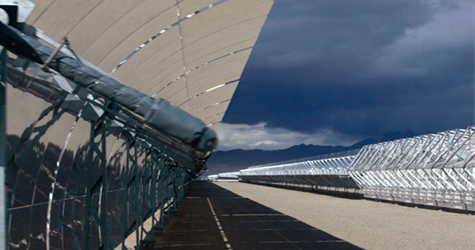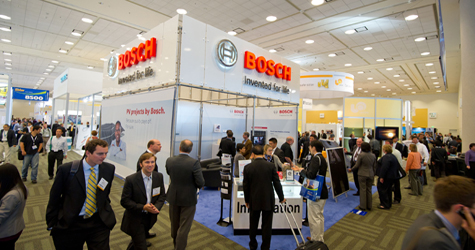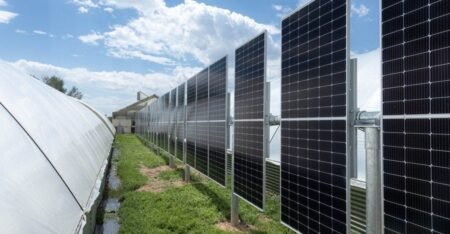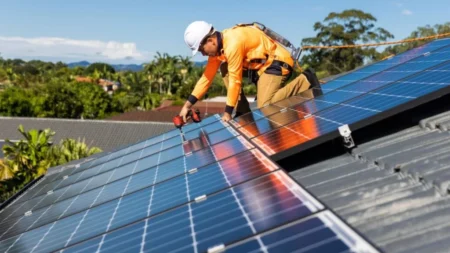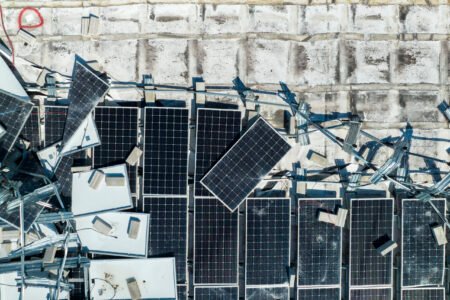Solar thermal technology is becoming an intrinsic part of heat production both in domestic and industrial applications around the world.
Innovative technologies are constantly expanding the fields in which solar thermal energy already finds application, as well as opening up new ones. Current trends and developments of the solar thermal industry are also a focus of the world’s largest exhibition for the solar industry, Intersolar Europe, which takes place from June 8 – 10. This includes innovative storage technologies and solar air conditioning as well as the solar thermal generation of industrial process heat, to name but a few examples. 600 exhibitors show solar thermal technology, 300 of them exhibit both solar thermal and photovoltaic technology. In an exhibition space covering 165,000 square meters, a total of 2,200 companies from Germany and abroad will present their products and services in the areas of photovoltaics, PV production technology and solar thermal technology.
Across the globe, solar thermal technology is continuously delving into new fields of applicati-onSso. The power of the sun is no longer just used for heating domestic water. If it were up to the German Solar Thermal Technology Platform (DSTTP) and their program entitled “Low Temperature Solar Thermal 2030”, solar thermal technology would be able to cover 50% of German heat demand by 2030. Which technologies will make this possible is being shown at the world’s largest exhibition for the solar industry from June 8 – 10 at the Munich New Trade Fair Centre.
Solar construction planning
Solar houses will be standard for new buildings in the foreseeable future. In solar houses, 50% of the annual demand of hot water and heating is covered by the power of the sun. Solar modernization with rooftop collectors and multifunctional facades is going to be normal for existing buildings. Here, too, the share of solar thermal energy is set to be 50% or more following modernization. Apart from heat generation, the multifunctional collectors of the future will fulfill additional tasks, such as heat insulation or the provision of light.
Long-term heat storage through innovative storage technology
The fluctuating availability of solar energy prevents thermal heat generation from providing con-stant amounts of hot water at all times. To achieve a high share of solar heat supply, heat has to be stored efficiently.
In addition to the development of hot water storage tanks with improved heat insulation, seasonal storage tanks will continue to establish themselves. They allow storing energy generated during the sunny summer months until the cold season. Current developments focus on latent heat accumulators, or PCM accumulators, which are based on phase change materials. PCS accumulators use the heat absorbed at a certain temperature for phase change, e.g. from solid to liquid. Heat accumulated in this way can be released when the phase change is reversed. This technology allows higher storage density and reduces heat loss, because the same amount of heat is stored at lower temperatures compared with a water storage tank.
The sun supplies industrial process heat
Process temperatures between 30° and 90° C are usually sufficient for industrial production in sectors such as the food and drinks industry, the textile and cellulose industry, the chemical industry, or for electroplating in the metal processing industry. Such temperatures can easily be reached with the current generation of collectors. Thus, solar thermal installations can provide part of the energy needed for production processes – without damaging the environment and independent of fluctuating raw materials prices.
Technical solutions have even been developed for process temperatures of up to 250° C. Currently, efforts to improve the efficiency of high temperature collectors using new concepts are ongoing in both industry and research institutions. The potential is enormous. Experts are expecting the demand for solar process heat, including medium temperature applications of up to 250° C at around 50 PJ per year in Germany – this would require around 35 Mio. m² of collector area.
To make solar medium temperature heat successful for industrial applications, standardized connections and transfer stations need to be developed, so that solar installations can be integrated into any process chain without major efforts.
Solar thermal technology in air conditioning and cooling technology
The demand for cooling energy is on the rise in commerce, industry and agriculture. The demand for cooling buildings is also increasing. The increased demand for cooling energy at times when there is a lot of solar energy available – around noon and on hot days—makes solar cooling ideally suited to provide this energy in the summer months.
Solar cooling can be used for almost all applications of air conditioning and cooling technology. The process used is adapted to the refrigeration plant. DEC (desiccant evaporative cooling) plants, which are based on the principles of dehumidification and evaporative cooling, are ideal for cooling buildings. Absorption and adsorption coolers are suitable for a wide range of applications. They are used for cooling in industrial processes and other cooling water applications, amongst others.
Solar thermal air conditioning is generally characterized by the interplay of different system components: solar installation, chiller or ventilation system, storage, hydraulic interconnections and control components. Designing and implementing the ideal combination of existing plant components for any particular application is one of the great challenges for solar air conditioning today.
Munich welcomes the international solar industry
From June 8–10, 2011 the international solar industry convenes at the New Munich Trade Fair Centre for Intersolar Europe 2011. The world’s largest exhibition for the solar industry features 2,200 international exhibitors presenting their products and services across 165,000 square meters of exhibition space, spanning 15 exhibition halls and an outdoor exhibition area. Over 75,000 national and international visitors will find out about the latest products and services in the fields of photovoltaics, PV production technology and solar thermal technology. An array of sessions, presentations and workshops at the Intersolar Europe Conference offer visitors the opportunity to get to grips with the exhibition topics and to engage in discussion with international experts. The conference runs for two days prior to and during the exhibition itself.



